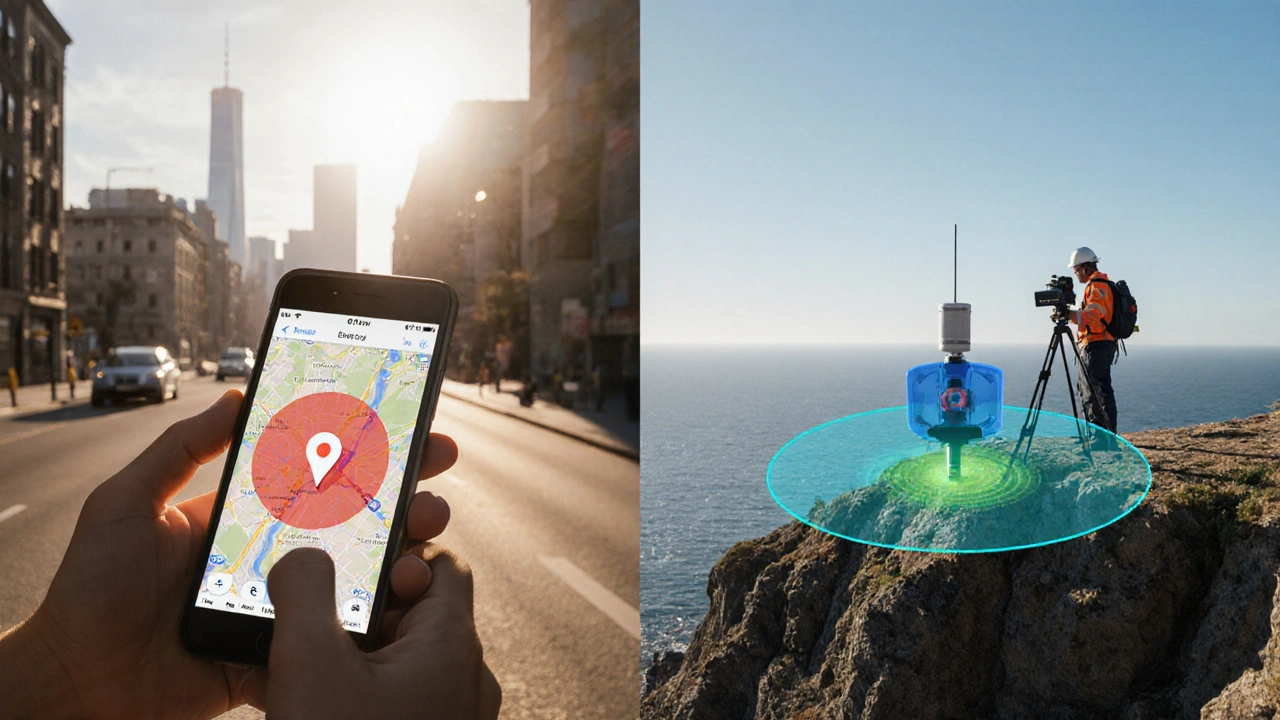When you rely on a smartphone or a car navigation system, you probably assume the reported position is spot‑on. In reality, ordinary GPS typically drifts 5‑10 meters because the signals have to punch through the ionosphere, dodge satellite orbit errors and survive occasional intentional degradation known as Selective Availability. That margin of error is fine for finding a coffee shop, but it can be disastrous for a survey crew, a pilot approaching a runway, or a cargo ship threading a narrow channel.
Enter Differential GPS (DGPS), a ground‑based augmentation that broadcasts real‑time correction data. By comparing the known coordinates of a reference station with the raw GPS reading, DGPS computes the difference - the “differential” - and ships that number to nearby receivers. The result? Positional errors shrink from several metres down to the 1‑3 meter range for most users, and even sub‑decimetre performance when a high‑grade base station is used. Because Differential GPS operates on a simple principle, it has become a workhorse for maritime, aviation, surveying and many other precision‑navigation fields.
How DGPS Works: The Three‑Step Cycle
DGPS follows a repeatable loop that can be broken into three core steps:
- Reference Monitoring - A fixed station whose exact location is surveyed to centimetre accuracy continuously receives the same GPS signals as any ordinary user.
- Error Calculation - The station compares the measured position with its known coordinates. The difference captures errors caused by satellite ephemeris, ionospheric delay, and tropospheric delay.
- Broadcast of Corrections - The calculated correction vector is transmitted via VHF/UHF radio, L‑band, 4G/5G or even the internet. Nearby receivers subtract this vector from their raw solution, producing a corrected position.
The whole process happens several times per second, allowing moving platforms to stay within a tight error envelope.
Key Components and the Errors They Tackle
Three error sources dominate standard GPS performance:
- Satellite Ephemeris Errors - Imperfect knowledge of the satellite’s exact orbit leads to position drift.
- Ionospheric Distortions - Charged particles in the upper atmosphere slow the signal, creating a range bias.
- Tropospheric Distortions - Water vapour and temperature variations in the lower atmosphere add another delay.
DGPS corrects each of these by using the reference station as a real‑world yardstick. The correction signal typically includes a range correction (meters) and a clock correction (nanoseconds) for each visible satellite.
Accuracy Gains: Numbers from the Field
Numerous studies have quantified DGPS performance. The U.S. Department of Transportation reported an error growth of 0.67 meters per 100 km from the broadcast site, while a Portuguese Atlantic trial measured only 0.22 meters per 100 km, highlighting regional variations. In practical terms:
- Standard GPS: 5‑10 m (95 % confidence)
- DGPS (typical): 1‑3 m
- High‑grade DGPS (centimetre‑level base): 0.1‑0.2 m
- RTK (state‑of‑the‑art): 1‑2 cm
For most maritime routes and land‑survey preliminaries, the 1‑3 m band offers a sweet spot between cost and accuracy.

DGPS vs. Other Augmentation Techniques
| Method | Typical Accuracy | Coverage | Primary Use Cases |
|---|---|---|---|
| Differential GPS (DGPS) | 1‑3 m (up to 10 cm with high‑grade base) | ~200 NM radius of each reference station | Coastal navigation, land‑survey preliminaries, aviation approach assistance |
| Wide Area Augmentation System (WAAS) | 1‑2 m | North America (continental coverage) | General aviation, recreational flying |
| Real‑Time Kinematic (RTK) | 1‑2 cm | Up to 30 km from base station (or networked) | High‑precision surveying, precision farming |
| Precise Point Positioning (PPP) | 0.1‑0.2 m (post‑processed) | Global (satellite‑based) | Geodesy, scientific research |
DGPS shines where a dense network of ground stations can be deployed, delivering solid metre‑level accuracy without the need for a satellite‑based service like WAAS. RTK beats DGPS on raw precision but requires tighter baselines and higher‑bandwidth links, making DGGS (DGPS‑ground‑based) more practical for many maritime and coastal operations.
Practical Implementation: What You Need to Know
Setting up a private DGPS solution involves three main tasks:
- Survey the Reference Site - Use a survey‑grade receiver to lock the station’s coordinates to <1 cm accuracy. The cost of a decent base‑station kit ranges from US$2,500 to US$8,000, depending on frequency support and ruggedisation.
- Choose a Communication Link - VHF radio (283.5‑325 kHz) is traditional, but many modern users opt for cellular 4G/5G or internet‑based NTRIP streams for lower latency.
- Configure User Receivers - Enable the DGPS correction input, ensure the receiver can see the same satellite constellation as the base (inter‑visibility), and set the correction age limit (usually <5 seconds).
The learning curve is moderate: professionals already familiar with GPS typically need 2‑3 days of hands‑on training to run a basic DGPS network. The biggest operational hiccup is maintaining “inter‑visibility” - obstacles like skyscrapers, deep valleys or dense foliage can block the shared satellites, causing the correction to become stale and accuracy to drop sharply.

Future Trends: Hybrid and Multi‑Constellation DGPS
DGPS is not a relic; it’s evolving. The International Hydrographic Organization’s new DGPS‑S‑100 standard (2023) adds support for GLONASS, Galileo and BeiDou, cutting the classic distance‑degradation curve. Hybrid systems now blend ground‑based DGPS data with Satellite‑Based Augmentation Systems (SBAS) and PPP corrections, delivering sub‑metre results even 150 km from the nearest base. The European Space Agency predicts that by 2027, three‑quarters of professional GNSS users will rely on such hybrid approaches.
Meanwhile, dual‑frequency civilian receivers are closing the gap with raw accuracy of 30‑50 cm, challenging the need for any augmentation. Yet many legacy platforms - especially maritime and aviation equipment certified before the dual‑frequency era - still depend on DGPS for regulatory compliance. As a result, the market is expected to shift toward integrated correction services rather than pure DGPS, but demand for local, high‑reliability corrections will likely persist in remote or infrastructure‑poor regions.
Quick Checklist for a Successful DGPS Deployment
- Verify reference station coordinates with a survey‑grade receiver (≤ 1 cm error).
- Ensure at least four common satellites are visible to both base and rover.
- Select a communication method that meets latency (< 5 s) and bandwidth needs.
- Configure user receivers to discard corrections older than the specified age limit.
- Plan for regular maintenance: antenna inspection, firmware updates, and correction‑source health monitoring.
Frequently Asked Questions
What is the main difference between DGPS and WAAS?
DGPS relies on ground‑based reference stations that broadcast corrections locally, typically covering a few hundred kilometres. WAAS is a satellite‑based augmentation that provides a continent‑wide correction envelope but with slightly less precision, generally around 1‑2 m.
How far can I be from a DGPS base station before accuracy degrades?
The theoretical limit is about 200 nautical miles (≈ 370 km). In practice, accuracy starts to drift noticeably after 50‑100 km, with error growth rates reported between 0.22 m and 0.67 m per 100 km depending on regional ionospheric conditions.
Can I use a smartphone as a DGPS rover?
Most consumer phones lack a DGPS input port, but some high‑end models support NTRIP streams over the internet, effectively allowing them to apply DGPS corrections. The accuracy gain, however, is limited by the phone’s antenna and processing capabilities.
Is DGPS still relevant after the discontinuation of Selective Availability?
Yes. While SA removal improved baseline GPS accuracy, typical civilian receivers still hover around 5‑10 m. DGPS still provides a reliable sub‑5 m envelope, essential for coastal navigation, cadastral surveys, and many aviation procedures.
What equipment do I need for a high‑precision DGPS setup?
A high‑grade reference receiver (Trimble, Leica or Septentrio), a precisely surveyed antenna mount, a VHF/UHF transmitter or internet‑based NTRIP server, and rover receivers capable of ingesting RTCM correction streams. Expect a total cost between US$5,000 and US$12,000 for a turnkey solution.
Whether you’re plotting a ship’s course through a busy harbor, laying out a new road network, or simply curious about how navigation gets that extra ounce of precision, DGPS offers a proven, cost‑effective bridge between raw GPS and the ultra‑precise world of RTK. By understanding its inner workings, limitations, and evolving hybrids, you can decide if it’s the right tool for your next positioning challenge.


5 Responses
The theoretical underpinnings of differential GPS are commendable; by leveraging a geodetically surveyed reference, the system attenuates ionospheric and ephemeris errors with elegant simplicity. It showcases how a terrestrial anchor point can be used to calibrate satellite‑derived positions, thereby reducing the stochastic component of the solution. Moreover, the broadcast of correction vectors exemplifies a pragmatic approach to real‑time error mitigation. In practice, this yields a consistent 1–3 meter reliability that far surpasses unaugmented civilian GPS. The methodology is both robust and scalable, making it a cornerstone for precision navigation.
I’m telling you the GPS is a hoax. They’re messing with our signals. Don’t trust the charts.
They don’t want you to know that DGPS is a tool for the deep‑state to surveil every vessel, and the correction broadcasts are a backdoor into maritime traffic. Ignoring this reality endangers not just cargo but national security.
One might begin by acknowledging the historical evolution of satellite navigation, a saga that commenced with the launch of the first Navstar satellites in the late 1970s. The subsequent proliferation of civil GPS receivers engendered a burgeoning reliance upon position fixes that, while revolutionary, were inevitably hampered by atmospheric perturbations and orbital imprecision. In response, engineers conceived differential augmentation, a concept both deceptively simple and profoundly effective. By situating a reference station at a precisely known coordinate, the system measures the discrepancy between the satellite‑derived position and the true location, thereby isolating the composite error vector. This vector, broadcast via radiowave or internet, permits any proximate receiver to subtract the measured bias and retrieve a corrected solution. The elegance of this scheme lies in its rapid refresh cycle, often occurring several times per second, which guarantees that even mobile platforms maintain a tight error envelope. Empirical studies, such as those conducted by the U.S. Department of Transportation, substantiate the claim that error growth can be confined to a few decimetres per hundred kilometres-a figure that starkly contrasts with the multi‑meter drift of raw GPS. Furthermore, the versatility of DGPS manifests in its compatibility with multiple transmission media, from VHF beyond line‑of‑sight to modern 4G/5G data streams, ensuring redundancy and resilience. The technology also dovetails with complementary augmentation systems, such as WAAS and RTK, offering a layered approach to precision that can be tailored to specific operational demands. In maritime contexts, the roughly 200‑nautical‑mile coverage radius of each base station furnishes coastal vessels with reliable fixes, mitigating the perils of narrow channel navigation. Likewise, in aviation, DGPS enhances approach procedures, granting pilots a more accurate situational awareness during critical phases of flight. Finally, the cost‑effectiveness of deploying a modest ground‑based network renders DGPS an attractive option for developing regions seeking to elevate their geospatial capabilities without incurring the expense of satellite‑wide services. Thus, differential GPS stands as a testament to the power of incremental correction, embodying a harmonious blend of simplicity, accuracy, and adaptability.
The explanation clarifies the practical steps nicely, and the error budget breakdown is useful.